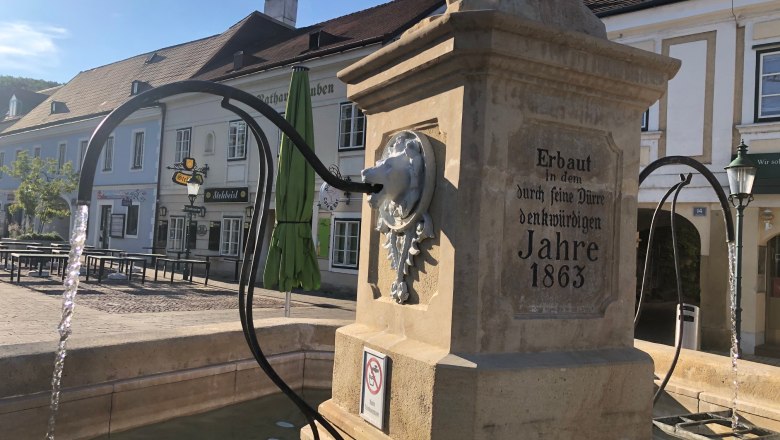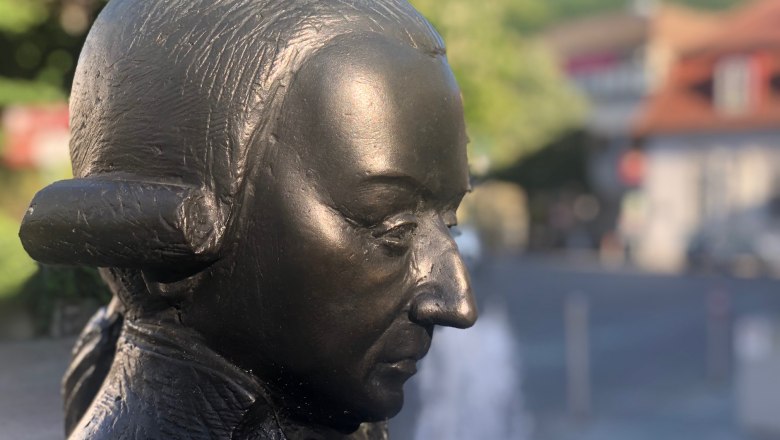Culture around the main square
The charming main square is the heart of Purkersdorf.
If you stand on the charming square, it is unimaginable that until the end of April 1987 all traffic on federal highway 1 (with around 11,000 vehicles per day) had to pass through the main square. After the completion of a bypass the main square has become a pedestrian zone, in which several cafés invite you to enjoy the sunny days in their outdoor terraces. A weekly market takes place here on Fridays.
Fürstenberg fountain
The Fürstenberg fountain at the eastern end of the main square bears the inscriptions: "Built in the year 1863, a memorable year due to its drought" and "Erected for the common good by the generosity of Her Excellency Mrs. Charlotte Landgraf zu Fürstenberg". Originally it stood at the confluence of Pummergasse with the main square. In the course of the redesign of the main square in 1988, the fountain was restored and repositioned.
Post office
The beautifully renovated building at Hauptplatz 5 is the former post office, which was then the first rest stop of the horse carriages on the Vienna-Linz route. The current building was erected at the end of the 18th century in a classical style with a facade decorated in relief, all of which relate to postal properties: e.g., trade, travel, vigilance, security, confidentiality of the postal service.
Milestone
In front of the house at Hauptplatz 8, the former toll house (and today's bank building) at the intersection with Kaiser-Josef-Straße, there is an original milestone from the 18th century. It originally stood on the corner of Kaiser-Josef-Strasse and Linzerstrasse.
Referring to the right direction (towards the national road B1) it contains an inscription under an imperial coat of arms "6 miles to St. Pölten", to the left direction (towards Kaiser-Josef-Straße) it says "Via Neulengbach to St. Pölten 5 miles". The "miles" indicated here refer to the then "Austrian post mile", which was just under 7.6 km.
Mozart monument
Since 2017, next to the milestone stand two male bronze figures dressed in baroque style: this is the Mozart monument by the Purkersdorf sculptor Dragutin Santek that commemorates the last meeting of Wolfgang Amadeus with his father Leopold. Leopold had visited his son in Vienna, and Wolfgang and his wife Konstanze accompanied him to Purkersdorf on April 25, 1785 before his journey home to Salzburg. In Purkersdorf they had lunch together and then said goodbye. It was the last meeting of the two.
In a letter dated April 30, 1785 Leopold writes to his daughter: “We finally left Vienna on the 25th of this at half past eleven in the company of your brother and his wife, had lunch together in Burkerstorf, they returned to Vienna, and we slept in St: Pölten, and were at 7 o'clock in the evening on the 26th in Lintz."
Jakobuskirche
The church is dedicated to St. James the Elder: this is no surprise, since Purkersdorf is on the Austrian St.James pilgrimage way, which leads from Vienna to Bodensee. After 1727 the church was considered an important pilgrimage church called "Maria Burkersdorf", to whose miraculous image of a "Maria lactans" many believers flocked from all over all regions. The painting is a replica of the miraculous image in the Vienna University Church, which in turn also is a copy of the "Donna Maria de Uzategui" in S. Rosa near Lima (Peru). It shows a half-length portrait of Mary, who extends her breast to the wrapped Jesus.
The first section of the St.James way west of Vienna begins at the church gate and leads via Herzogenburg to Göttweig.
Castle
The Purkersdorf Castle is located behind the church at Hauptplatz 6. The building was originally erected as a moated castle with strong walls. The first documented mention was in 1255, when king Ottokar II of Bohemia was the sovereign. From around 1500 the Imperial Forest Administration ("Kayserliche Waldambt") had its seat here. The building was destroyed and rebuilt several times. It was used almost continuously as a forest administration office and is owned by the Austrian Federal Forests that have built their architecturally appealing headquarters right next to the castle in 2002.
A carriage from the 2nd half of the 19th century, which was then used on the Vienna-Purkersdorf-Sieghartskirchen line, is on display in a show garage at the castle entrance. This "post autobus", which had 14 seats in 3 price categories, is the only surviving vehicle of this type in Europe.
City Museum
The Purkersdorf city museum has been housed on the ground floor of the castle since 1986 and documents the history and development of Purkersdorf. The focus is on the development of a small village, whose supraregional importance is based on the administration of the Wienerwald and the strategic location on the main route from Vienna to the west. A large part of the exhibition is dedicated to Purkersdorf artists: the poet Hildegard Jone (1891-1963), her husband, the sculptor, painter and graphic artist Josef Humplik (1888-1958) and the sculptor Horst Aschermann (1932-2005).
Further information is available on the website of the city museum. The city museum can be visited by making an appointment: stadtmuseum@purkersdorf.at

